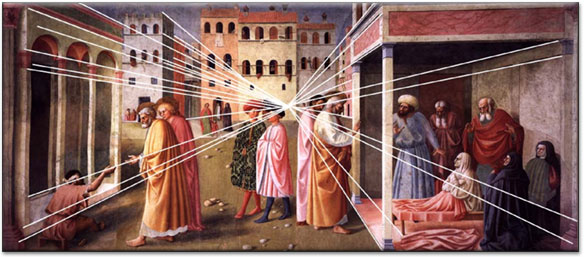Week 2: Math + Art
I would conclude this week’s lesson as that Math is used to create and explain art in many ways. Such conclusion is drawn after I came across the concepts of vanishinig point, golden ratio and the digital representation of sound, etc.
Firstly, the idea of vanishing point is an important method which can make a portrait realistic. Such concept is new to me and impresses me very much, because I finally find out why my paintings always seem strange. Of course, this problem also involves the matter of proportion, one of the three principles of painting stated by Piero de la Francesca.
 |
| An example of vanishing point - Masolino da Panicale, 1425 (from Google Images) |
Secondly, golden ratio is a formula used to create art in different fields. It can also be used to explain why an art work, or even a human body, is aesthetically appealing. One thing interesting is that golden ratio can be found in the nature, which makes me feel that it is a principal of the Earth’s art.
Thirdly, the relation between sound and Math is special. Sound can be presented as a function, because it is a vibration of particles in the medium. Understanding the digital property of sound, we can use computer to mess around with sound and create art with this modern method.
 |
| Minute portion of the sound wave file (from Google Images) |
An artist who impresses me greatly is Piet Mondrian. Mondrian believed that math and art were closely connected. He used the simplest geometrical shapes and primary colours (blue, red, yellow) to express reality, nature and logic from a different point of view. The Golden Rectangle is one of the basic shapes, which keeps appearing in Mondrian's art. I have seen Mondrian’s work in an art museum, and I was surprised that an art work can ever be so tidy and “math” while maintaining its aesthetic value. One interesting thing is that Piet Mondrian’s works can also be used as sources for children’s enlightenment education of Math.
 |
| Piet Mondrian's abstract trees art painting (from Google Images) |
However, even if Math is a language which is critical in the study of visual art, artists have already been removed from math when they study art, a process Buckminster Fuller called “degenuising”. As far as I am concerned, math and science are building blocks of an art work, aesthetically or technically. Therefore, I think it is necessary for today’s education systems to recognize math and science as integral parts of art education to avoid “degenuising” future artists.
Sources:
Frantz, Marc. “Lesson 3: Vanishing Points and Looking at Art”, 2000. Print.
Unknown. “Golden ratio”. Wikipedia.
Burk, Phil, et al. “Music and Computers, A Theoretical and Historical Approach”, 2011. Accessed 12 Apr 2017. Web.
Primary Magazine. “The Art of Mathematics, Piet Mondrian (1872-1944)”, NCETM, 4 June 2009. Accessed 12 Apr 2017. Web.
Parveen Nikhat. “Mathematics and art”, UGA. Accessed 12 Apr 2017. Web.
“Mathematics-pt1-ZeroPerspectiveGoldenMean.mov”. Uconlineprogram. Youtube, 2012. Video.
No comments:
Post a Comment